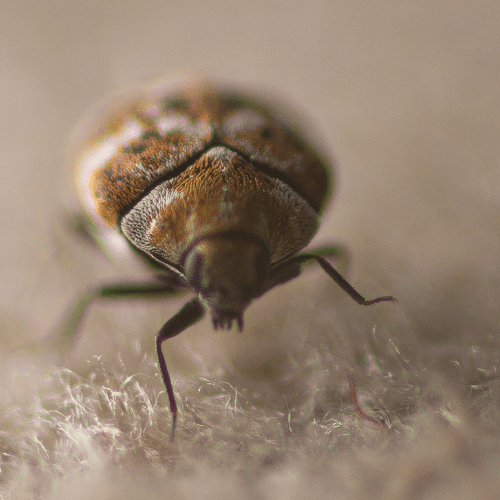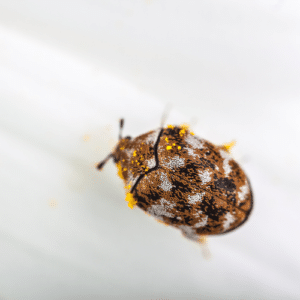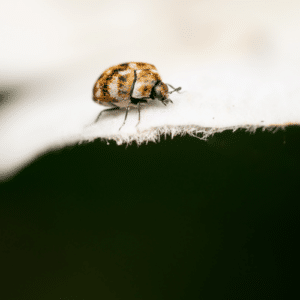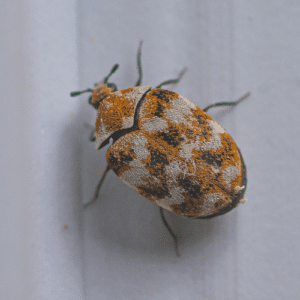
31 Jan Carpet Beetles Uncovered and Eliminated
Carpet Beetles Don’t Let Them Win
Carpet beetles are one of the most overlooked yet destructive pests that homeowners and business owners in South Florida may encounter. These tiny insects feed on natural fibers, damaging carpets, upholstery, clothing, and even stored pantry items. Their larvae cause the most harm, leaving behind holes in fabric and contaminating food sources. Detecting an infestation early is crucial for preventing costly damage and ensuring a pest-free environment.
As a family-owned organic pest control company, Pest Busterzz understands the challenges South Florida residents face when dealing with persistent pests. Carpet beetles thrive in warm, humid climates, making regular inspections and preventative measures essential. This guide will help you identify carpet beetle infestations, manage existing problems, and implement effective prevention strategies to keep your home or business protected.
Silent Fabric Destroyers
South Florida is home to several species of carpet beetles, each with distinct characteristics. The varied carpet beetle is a small, oval-shaped insect with a mix of white, brown, and yellow scales on its back. The black carpet beetle, slightly larger, has a solid dark brown or black body. The furniture carpet beetle is similar to the varied carpet beetle but has more pronounced patterns on its shell. These species are known for their ability to infest homes, thriving in warm indoor environments where natural fibers and organic materials are abundant.
While adult carpet beetles primarily feed on pollen, their larvae cause damage by consuming wool, silk, leather, and other natural fibers. These pests often go unnoticed until damage appears, making it important to recognize their presence early. Understanding the species common to South Florida helps homeowners and business owners take targeted action before infestations escalate.
Carpet beetle infestations can be challenging to spot initially. Adults are often found near windows or light sources, as they are attracted to natural light. Their larvae, however, prefer dark, undisturbed areas such as closets, storage boxes, and under furniture. These small, bristly larvae leave behind shed skins as they grow, which can be an early sign of an infestation.
Other indicators include small holes in clothing, fabric furniture, and carpets, as well as damaged books and dried food products. If you notice tiny beetles on windowsills or unexplained damage to textiles, a carpet beetle infestation may already be present. Regular inspections of fabric storage areas and food pantries can help detect these pests before they cause significant harm.
Where Carpet Beetles Hide and Thrive
Carpet beetles can invade almost any part of a home or business, but they tend to target areas rich in natural fibers. Carpets, upholstered furniture, and wool rugs provide ideal feeding grounds for larvae. Closets and storage areas where clothing, blankets, or linens are kept are also high-risk locations. Even taxidermy mounts, feather pillows, and leather-bound books can attract these pests.
In commercial settings, carpet beetles can infest office furniture, warehouses, or retail stores that carry fabric-based goods. Restaurants and food businesses may also experience issues, as some carpet beetle species feed on grains, dried goods, and pet food. Keeping these areas clean and regularly inspecting stored items reduces the chances of an infestation.
Carpet beetles often enter properties from outdoor sources. Their adult forms feed on pollen and can hitch a ride indoors through open windows, doors, or on clothing. Once inside, they seek out dark spaces to lay eggs, which can hatch within a few weeks. Second-hand furniture, antique rugs, and even decorative dried flowers may introduce beetle eggs or larvae into a space.
Another common entry point is through attic vents, cracks in the foundation, or gaps around doors and windows. Because South Florida’s climate supports rapid reproduction, even a small number of beetles can quickly lead to a full-blown infestation. Sealing potential entryways and inspecting incoming items can minimize the risk of carpet beetles establishing themselves indoors.
Hidden Pests Leaving Clues
Detecting carpet beetles early can prevent extensive damage. Some of the most common physical signs include:
Small, round holes in clothing, upholstery, or carpets.
Tiny beetles crawling near windows or lights.
Shed larval skins in closets, drawers, or along baseboards.
Fine, powdery debris near infested materials, caused by larvae chewing through fibers.
These pests tend to remain hidden until the damage becomes noticeable. Regular inspections of fabric-based items, particularly those stored for long periods, can help detect infestations before they worsen.
Some people experience skin irritation from carpet beetle larvae. Their bristle-covered bodies can trigger mild allergic reactions, including rashes or itching, similar to bed bug bites. Unlike bed bugs, carpet beetles do not bite humans but can cause discomfort through indirect contact. If unexplained itching or irritation occurs, checking for carpet beetles may help determine the cause.
Cleaning Methods to Eliminate Carpet Beetles
For minor infestations, thorough cleaning can help reduce carpet beetle populations. Vacuuming carpets, rugs, and furniture removes larvae, while washing infested clothing and bedding in hot water kills eggs and larvae. Storing fabric-based items in airtight containers prevents further damage.
Deep cleaning should focus on undisturbed areas like air vents, behind furniture, and inside storage boxes. Steam cleaning carpets and upholstery adds another layer of protection, as high heat effectively eliminates pests. Regular maintenance of these areas reduces the likelihood of re-infestation.
Natural repellents such as lavender, cedarwood, and peppermint oils can deter carpet beetles. Placing cedar blocks in storage areas or using essential oil sprays near high-risk locations can help. However, for severe infestations, insecticidal sprays or dust formulations may be necessary.
Pesticides containing boric acid can be effective but should be used cautiously, particularly in homes with pets or children. In cases where DIY methods do not resolve the issue, professional pest control services provide targeted treatments that ensure complete removal.
Keep Carpet Beetles Out for Good
Keeping your home or business free of carpet beetles requires ongoing efforts. Regular vacuuming, reducing indoor humidity levels, and promptly addressing fabric damage help prevent infestations. Sealing cracks around windows and doors also reduces the chance of beetles entering.
For businesses that store fabric-based goods, maintaining proper storage conditions is key. Rotating inventory, inspecting deliveries, and keeping storage spaces clean can prevent pests from settling in. Regular monitoring ensures that any potential infestations are caught early.
Carpet beetle infestations can be difficult to manage without expert help. Pest Busterzz specializes in organic pest control solutions that eliminate carpet beetles safely and effectively. Our eco-friendly treatments target infestations while keeping your home or business safe for people and pets.
With our expertise in Miami-Dade, Broward, and Palm Beach County, we provide customized pest control plans that address both active infestations and long-term prevention. Contact Pest Busterzz today to schedule an inspection and keep your space carpet beetle-free.
Conclusion
Carpet beetles can cause extensive damage if left unchecked, feeding on natural fibers and contaminating stored goods. Identifying early signs, such as fabric holes or shed skins, helps prevent costly repairs and replacements. Cleaning, sealing entry points, and using natural repellents reduce the likelihood of infestation.
While DIY methods can help in minor cases, professional pest control ensures thorough removal. Pest Busterzz provides safe, effective, and eco-friendly pest management solutions tailored to South Florida’s unique environment. Don’t let carpet beetles ruin your home or business—contact us today for expert assistance!






No Comments